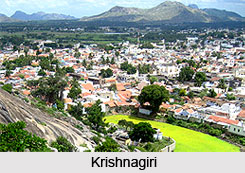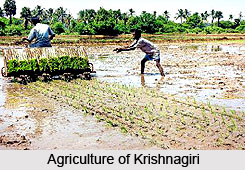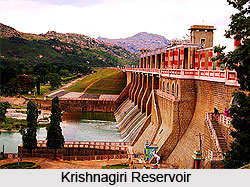 This is the place, which was carved out of Dharmapuri district and regarded as the 30th district of Tamil Nadu. The name `krishnagiri` is derived from `Krishna` that means `black` and `giri` means `hill`. This district is gifted with black granite hillocks and thus named as `krishnagiri`.
This is the place, which was carved out of Dharmapuri district and regarded as the 30th district of Tamil Nadu. The name `krishnagiri` is derived from `Krishna` that means `black` and `giri` means `hill`. This district is gifted with black granite hillocks and thus named as `krishnagiri`.
There is another saying which gives the idea of naming the district and this can be mentioned as in earlier days the region came under the rule of Krishna Deva Raya and hence it might have been named after this king.
The four boundary of Krishnagiri district can be mentioned as it is bounded by Vellore and Thiruvannamalai districts in the East, Karnataka state in the west, Andhra Pradesh in the North and Dharmapuri District in the south.
The total geographical area of the district is 5143 Sq. Kms. This district is elevated from 300m to 1400m above the mean sea level. It is located between 11º 12`N to 12º 49`N Latitude, 77º 27`E to 78º 38`E Longitude. Eastern part of the district is hot while Western part has a contrasting cold climate.
The average rainfall is 830 mm per annum. The summer season can be experienced from March- June. July-November is Rainy Season and between December-February winter season is there. Three languages namely Tamil, Telugu and Kannada are spoken mainly here in this district. Major religions are Hindu, Islam and Christianity. All the people live with full integration and harmony. The people of different languages as well as cast and creed live here with full confidence.
The total population of the district is 15,46,700. Out of which 7,95,718 are males and 7,50,982 are females. Density of the population per sq. km is 301. Sex ratio of this district is 944/1000. The literacy rate is 58.11%.
The tribal folk named `Irular` live in the forest of Denkanikottai. These people are skilled in tree climbing, honey collection and protecting themselves from wild animals as well.
Roadways:
Prime Minister`s Golden Rectangle Project executed by National Highways Authority of India connects this district. The district has many national highways running along the district and these are as follows:
NH-7, which runs through Kanyakumari-Kashmir, NH-46 that runs through Chennai-Bangalore, NH-66 runs through Pondicherry-Bangalore, NH-207 runs through Sarjapur-Bagalur-Hosur, and NH-219 runs through Krishnagiri-Kuppam.
Apart from these NH`s state highways and district highways are linking almost all the towns and villages of the district. Four National highways converge at the Head Quarters of this district is a unique instance.
People of different casts and creed live in this Krishnagiri District. People from Kashmir, Maharashtra, Karnataka and Andhra have settled in this District as well. Hence this district can be truly called as a Cosmopolitan society. Ancient Art & Culture is preserved and maintained by inhabitants. The major entertainments for the people living here can be mentioned as `Street Play` or theru koothu and `Sevai Attam`.
Agriculture:
The important crops of Krishnagiri District can be named as Paddy, Maize, Ragi, Banana, Sugarcane, Cotton, Tamarind, Coconut, Mango, Groundnut, Vegetables and Flowers. The district is mainly agrabian,i.e. high scopes for agri business is available here. Since 1973 AD Regional Agricultural Research Center of Tamil Nadu Agricultural University is functioning efficiently at Paiyur in Kaveripattinam union. This center is functioning in 18.5 hec. of land. It helps the agricultural labourer to develop and adopt the modern technique of cultivation. It has developed hybrid seeds by research, which yields more tonnage and good quality as well.
Paddy is cultivated in the area of 20,687 Hec, ragi is cultivated in the area of 48,944 Hec, sugarcane is cultivated in 4,078 Hec while pulses and other minor crops are cultivated in 48,749 Hec and 11,937 Hec respectively.
 Horticulture:
Horticulture:
The land of Krishnagiri District is more suitable for cultivation of Horticulture crops. Other Plantation crops, medicinal plants, Fruits, Vegetables, Spices, and flowers are grown well by way of its moderate climate, high altitude and fertility of the soil. Horticultural crops are cultivated in the area of 38,248 Hec. Fruits are cultivated in the area of 32,162 Hec, vegetables are cultivated in the area of 9,773 Hec whereas spices and flowers are cultivated in the area of 4,398 Hec and 1,115 Hec respectively.
Sericulture:
In Krishnagiri District at about 5069 acres of land is under mulberry cultivation. This has the employment opportunity for about 24,345 persons at the rate of 5 per acre as well. Training in Mulberry farming, Rearing Silk Worms is done through a large network of Govt. Departmental Institutions of Sericulture such as Silk quality development farms, Govt. Sericulture training center, Govt. Sericulture Farm, Base seedlings (grain age) development farms, Govt. Bi-voltine grain age centers, Govt. Cocoon markets, Silk Reeling Unit, Silk Twisting unit, Technical support and service center for rearing silk worm, etc. With all these above-mentioned facilities sericulture industry has good scope in this district.
Natural resources:
Krishnagiri is abundant with natural resources having 2,024 Sq. Kms of forest. This forest-covered area gives a refreshing look to the district. This can also be regarded as the unique feature of the district. The hill ranges of this district are called by the name `Melagiri`. The major type of forest that are seen predominant here are the Tropical, Deciduous forests, thorny shrubs and bamboo forest. The Denkanikottai region is always covered by dense forest. The other region contains shrubs, hills and hillocks with bushes. People enjoy the beauty of forest very much.
Flora and fauna:
The major wild animals that are found in this district are mainly Elephants, Sambar, Spotted Deer, Gaur, Wild boar and Panther etc. The forest area of Denkanikottai Taluk forms the prime elephant habitat with lot of bamboos. This area also constitutes the Cauvery elephant reserve. This elephant reserve is constituted over and area of about 450 Sq. Kms. The bird population is also attractive at this place with beautiful bird like Paradise flycatcher. Big lakes in Anchetti and Hosur areas also attract large number of migratory birds like Painted storks, Teals etc. Apart from these birds and mammals, there are variety of butterflies, giant spiders etc. Some of these are going to be endangered list and also can be extinct in near future. Migratory butterflies also come to this place. Kodakkarai shoal forest in Denkanikottai Taluk is known for large scale migratory butterflies during a particular season then one can observe thousands of migratory butterflies passing through this forest.
The district is a paradise for natural lovers. The flora includes variety of timber trees like Rose wood, Teak, Sandal etc. There are hundreds of medicinal herbs, minor forest plants like nelli, kadukkai, cheekai, pungam etc. are also very much present. Another important tree namely pungam trees are found in abundance in this forest. That is the reason pungam oil is extracted from this seeds of this tress, which is a non-pollutant Bio-fuel.
Economic Importance Of Natural Vegetation:
The Vast forest resource that is present in this district is really a unique feature. In these forests many important trees are present and these can be mentioned as Sandal, Teak, Rose Wood and Bamboo. The timber from these trees has great demand for structural works, e.g. House construction, Shipbuilding, Paper and pulp manufacture, Pencil and Ply wood Industry, etc. Growing nursery for herbs and medicinal plants, extraction sandal wood oil for perfumery is regarded as the major contribution for the industrial growth in Krishnagiri District. The forest products like bamboo rice and honey supplement the food for tribal and in this way the forest benefits them.
Minerals and industries:
The district Krishnagiri is very famous for its minerals and industries. "Paradise" is the most popular multi coloured granite available in Krishnagiri. Black granite is available in Hosur and Denkanikottai. In Hosur surroundings many granite-processing units are present. At these units making slabs of granite, finishing and decorating the granite beautifully is done very successfully. The multi coloured paradise slabs are being exported to America, England, Australia and some other European countries in large quantities. This industry is flourishing with the uninterrupted supply of electricity and availability of raw material and land at cheaper rates. A variety of quartz stones from Denkanikottai and White metal called Limestone from Uthangarai are mined at this place.
Rivers:
 The main rivers that flow across the district are Kaveri and South Pennar Kaveri. This enters the district from South West in Denkanikottai taluk and exists in South West direction. It forms a waterfall at Hogenakkal and joins Mettur Dam. South Pennar originates in Nandidurg of Karnataka and flows through Hosur, Krishnagiri and Uthangari Taluks as well. Vanniyar and Markanda rivers join this South Pennar.
The main rivers that flow across the district are Kaveri and South Pennar Kaveri. This enters the district from South West in Denkanikottai taluk and exists in South West direction. It forms a waterfall at Hogenakkal and joins Mettur Dam. South Pennar originates in Nandidurg of Karnataka and flows through Hosur, Krishnagiri and Uthangari Taluks as well. Vanniyar and Markanda rivers join this South Pennar.
Reservoirs:
This Krishnagiri district has many reservoirs namely Krishnagiri Reservoir Project, Shoolagiri-Chinnar Reservoir, Thangarai Reservoir, Pambar Reservoir, Kelevarapalli Reservoir Project and Baarur Tank. These are the sources of irrigation for our district. At about 18,965 Hec of land is irrigated by all these water reservoirs.
Places of worship:
Some of the holy places that are very famous at this district can be mentioned as Arulmigu `Penneswarar Moorthy` temple, `Lakshminarayana` temple of Krishnagiri, `Kundeeswarar` temple of Chinna Kothur, `Angalamman` temple of Kaveripattinam, `Balamurugan` temple of Jagadevi, `Chandra choodeswarar` temple of Hosur, and `Bettaraya Swamy` Temple of Denkanikottai. All of these are few among the holy places of this Krishnagiri District. Stone inscription reveal that these temples were built during Chola and Vijaya Nagar periods. The Holy Dharga of Denkanikottai, The Sacred Heart Church of Krishnagiri are other popular sacred places in this district. People can quench their religious thrust after visiting the temples here.



















